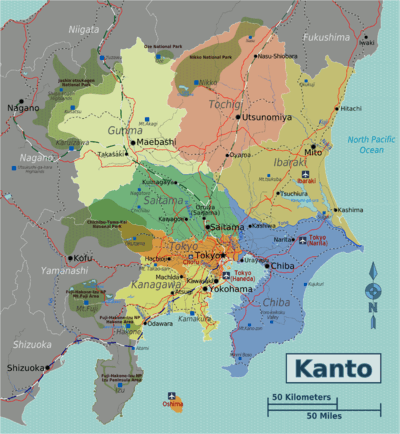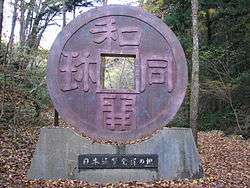Kanto
The Kantō (関東) region of Japan, on the eastern side of the main island Honshu, is a broad plain dominated by and nearly synonymous with the megalopolis of Tokyo and its suburbs.
Prefectures

| Tokyo contains not just the biggest city in the world, but mountains and semitropical islands too |
| Kanagawa suburban sprawl to the south containing Yokohama, Japan's second largest city, and Kawasaki |
| Chiba suburban sprawl to the east and the site of Narita of airport fame |
| Saitama suburban sprawl to the north containing beautiful scenes and very hospitable people |
| Tochigi popular escape known for historical site Nikko and many hot springs |
| Gunma mountains and hot springs to the north of Tokyo |
| Ibaraki coastal prefecture containing the hometown of natto, Mito |
Cities
- 🌍 Chiba - another Tokyo offshoot to the east
- 🌍 Kawasaki - suburb sandwiched between Tokyo and Yokohama
- 🌍 Tokyo - capital of Japan, largest city in Japan
- 🌍 Yokohama - officially Japan's 2nd largest city, in practice a giant Tokyo suburb.
- 🌍 Kamakura - temple town within easy striking distance of Tokyo
- 🌍 Nikko - the grandiose mausoleum of the Tokugawa shoguns
- 🌍 Kinugawa - former hot spring boomtown fallen on hard times
- 🌍 Mashiko - town of clay pots and steam locos
- 🌍 Saitama - Bonsai capital of Japan
Other destinations

- 🌍 Oze National Park - the largest highland marshland on Japan's main island of Honshu.
- 🌍 Chichibu-Tama-Kai National Park - mountain hiking within easy striking distance of Tokyo
- 🌍 Enoshima - Japan's surfing paradise in style and attitude (a shame there isn't much in the way of waves)
- 🌍 Fuji-Hakone-Izu National Park - for hot springs and views of Fuji
- 🌍 Noda - home to Japan’s largest field-athletics course Shimizu Koen.
- 🌍 Odawara — houses the only Japanese castle in greater Tokyo area
- Yugawara , Manazuru — for hot springs and coastal resort, eating sashimi and mikan, views of Manazuru Peninsula, some festivals(Matsuri).
Get in
Most visitors arrive in the Kanto region via Tokyo, and most of those arrive via Narita Airport, Japan's main international gateway.
Understand
In feudal times, Kanto was the home of the Tokugawa shogunate and Edo (modern Tokyo) the military seat of power, while the western region of Kansai represented commerce (Osaka) and culture (Kyoto). For much of Japanese history, nobody called Tokyo the capital of Japan, but the pendulum shifted decisively in Tokyo's favor after the 1868 Meiji Restoration when the Emperor moved to Tokyo, and today Kanto sets the pace that the rest of Japan tries to follow.
Talk
The Kanto dialect is the base of the standard Japanese taught in schools and spoken on TV, but elderly people in some rural areas such as Ibaraki and Tochigi speak particular dialects which differ from standard Japanese.
Unlike the Japan of 30 years ago, it is very possible to get by in Kanto even if you only speak English, as most signs and the trains are very accommodating to travelers. Also, some natives in city areas have a little experience with English - just speak slowly.
See
Do
Eat
The Michelin Guide gave more stars to Kanto (Tokyo) dining establishments than any other city in Japan.
Compared with their western cousins in Kansai, the people of Kanto prefer dark soy to light soy, thin buckwheat soba noodles to fat wheat udon and appreciate the taste of the odoriferous fermented soy bean product natto.
Drink
Stay safe
If safety is the ratio of population density to frequency of crime, then Kanto has to be the safest place in the world. It is mind-boggling how such a densely populated urban area can have such a low crime rate, especially in violent street crime. Nonetheless, there are omnipresent "police boxes" to keep things in order. What's more, disease is much less of an issue in Japan than in much of Asian travel, you can trust the food to be well prepared, and though Tokyo may be a little more polluted than, say, Kyoto, even in downtown Tokyo the air is crystal clear compared to Beijing, and good luck finding garbage or food on the sidewalks and streets. All in all, Tokyo is definitely among the safest, cleanest, most pleasant urban traveling experiences to find on Earth - and Tokyo is likely the dirtiest and most dangerous part of Kanto.